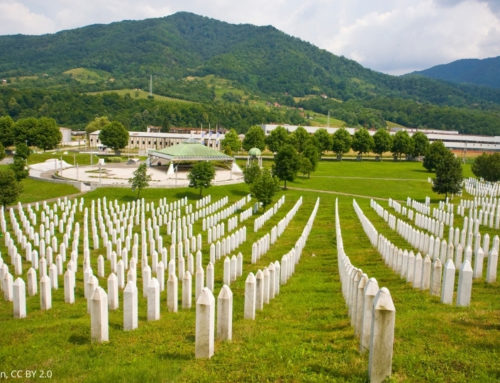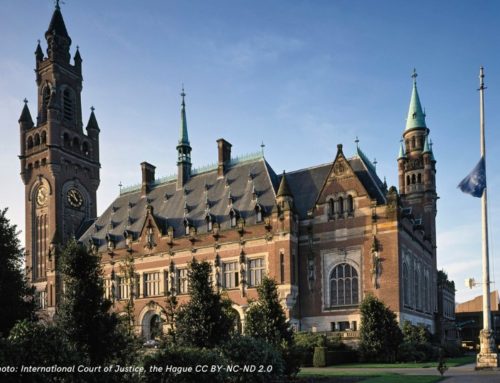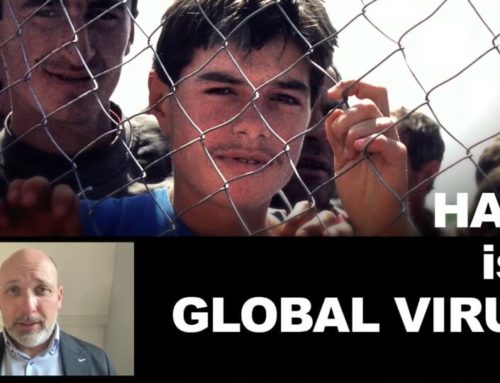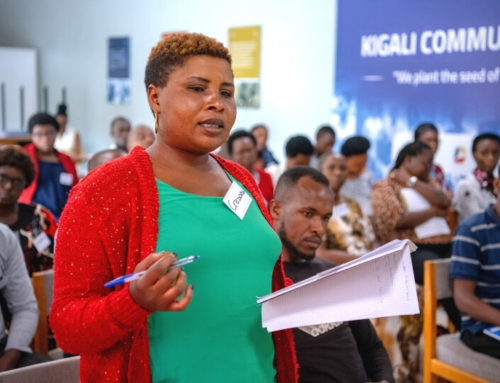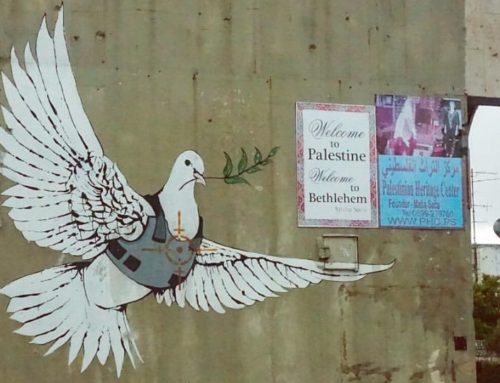 31 Jan 14 – Speaking at the National Holocaust Centre to an audience of survivors, school children, educators and supporters on Tuesday this week at a special event to mark Holocaust Memorial Day, Dr James Smith CBE – Chief Executive of the Aegis Trust and President of the Holocaust Centre – helped to set the ball rolling on a public consultation initiated by David Cameron (view speech here).
31 Jan 14 – Speaking at the National Holocaust Centre to an audience of survivors, school children, educators and supporters on Tuesday this week at a special event to mark Holocaust Memorial Day, Dr James Smith CBE – Chief Executive of the Aegis Trust and President of the Holocaust Centre – helped to set the ball rolling on a public consultation initiated by David Cameron (view speech here).
Launching a Holocaust Commission the day before to explore what more should be done for Holocaust commemoration and education in the UK, the Prime Minister had asked what students 50 years from now should be learning about this subject.
In a thought-provoking speech drawing particularly on one survivor’s experience of two events in the Nazi period – Kristallnacht, and the Rosenstrasse protest – Dr Smith, one of the experts appointed to advise the Commission, suggested that there are three principle purposes for commemoration and education. First, to dignify the memory of the victims; second, to acknowledge the suffering of survivors; third, to offer both warning and inspiration for the future. If we could understand the impact of actions and inactions during the Holocaust era, he suggested, we could draw important lessons for the present and future.
“When that generation of 2064 look back to assess how we rose to this challenge, they may first ask whether we did all we can to preserve knowledge of those times, to represent victims with respect and dignity, and to engage as wide an audience with the Holocaust as possible,” James Smith said. “But secondly, when they observe the social ills in their time, they may ask what we did to ensure that Holocaust remembrance provides not only a warning but a tool to mitigate the danger that prejudice represents to our civilisation.”
Shadow Justice Minister Stephen Twigg MP, Chair of the All Party Parliamentary Group for Genocide Prevention and Schools Minister in the last Labour Government, followed Dr Smith at the podium (view speech here). Arguing that both the teaching of key facts and the teaching of critical thinking are essential to Holocaust education, Twigg alluded to footballer Nicolas Anelke’s use of the quenelle gesture, antisemitic chants at a demonstration in Paris this week, and the rise of the extreme right-wing Jobbik party in Hungary as signs of the importance and relevance of Holocaust Memorial Day and the educational work of the National Holocaust Centre and Aegis Trust.
The text of James Smith’s speech and Stephen Twigg’s speech, as contained in the film edits, can be read below.
JAMES SMITH SPEECH
Yesterday, at a reception in Downing Street for Holocaust survivors, Prime Minister David Cameron asked, “When students learn about the Holocaust 50 years from now, in 2064, what will they be viewing, and what will they be learning?”
To answer these questions he launched a commission yesterday. A Holocaust Commission to examine what more can be done in support of Holocaust commemoration and education.
It’s a privilege that I’ve been asked to advise that commission, and Henry Grunwald, our Chair of Trustees here at the Holocaust Centre, is also a member of the education working group.
At the National Holocaust Centre here in Nottinghamshire, over 20,000 pupils come through this centre every year. Yet there remains a huge amount more that can and therefore should be done.
Here are the three purposes of commemoration and education about the Holocaust that I regard most highly.
First, to give dignity to the victims of the Holocaust. One of the reasons that the Holocaust occurred in the first place is because there was such little respect for Jews, and for the right of Jews to live in Europe. So providing dignity as a community for the victims of the Shoah means that we reject those attitudes of the 1930s and 40s and it enables us to affirm our own humanity and express values that respect everyone’s right to life and liberty.
The second purpose for commemoration and for memorials, I believe, is for survivors. It acknowledges the crime publicly. And the suffering. And therefore it’s a contribution to justice – what we might call transitional justice – and reparation, healing, in its broadest sense.
The third reason and purpose of commemoration and education for me is that memory should be a warning. And it should be for education. And a warning through education.
If you’ve been downstairs to the permanent exhibition – I’m sure most of you have – you won’t have missed a large photograph of a burned-out synagogue. This synagogue is on Fasanenstrasse in Berlin.
Last week I met a wonderful woman in San Francisco called Rita Kuhn. And she’d grown up in Berlin. Her father was Jewish. Her mother was too, having converted to Judaism from a nominal Lutheran family.
Rita lived 14 blocks from Fasanenstrasse. She would walk the four blocks down to Kantstrasse and then all the way down Kantstrasse towards her school at the synagogue.
On the morning of the 10th of November 1938, she as usual made her way down Kantstrasse. But this time was different. Two friends came the opposite direction, calling to her, and told her that their beloved synagogue was burning and that the fire services were not only watching but protecting the neighbouring buildings from catching fire while the synagogue burned. And that was when Fasanenstrasse synagogue became the ruin that we now display.
So the question is, are we doing enough, when we have our images and these artefacts, to bring your stories, and connect your stories, and to bring all this to life as we should be doing. I think we take it for granted at the moment that you’re here, speaking to students that come, telling your stories, making it all personal. But as the Prime Minister said, we need to be thinking of 2064, and our responsibility to make sure that these photographs, these images, these artefacts are as personal as you make them today.
But it’s not just how we tell the story and what we tell. If commemoration is about a warning from history, we have to be asking ourselves the question, how do we convey this to the children in 2064? What is it we’ve learned from Kristallnacht? What was happening as 11-yr-old Rita walked down that street with that shattered glass, and that red paint daubed on those walls, and the smoke from the synagogue? What was it that the German neighbours were doing and saying? And how did that affect the dynamic in the country in terms of what the hierarchy would do next? And more importantly, how was the UK responding, and other powers around Germany, responding to that night that was widely reported? And if our response was too muted, were we perhaps giving a green light to the Nazis that they could take it a step further?
It’s not just Governments that need to learn these lessons. Through our education we should also be asking about communities and individuals, and our silence in the face of these kind of atrocities.
I’m going to end with one more anecdote because in terms of hope and inspiration that we can bring to students in the future, we should ask if we’re doing enough to reach into history and explore the stories of the heroes. Rescuers were so few. But they’re such an important minority. And if we want to have a safe, peaceful coexistence in the future, we need to know how to transmit those kinds of values through our education.
By 1943 Rita was 14 years old, and she was being used, as the final Jews in Germany were, as forced labourers. But in 1943 they were rounded up and arrested, and they were taken to a place, a street called Rosenstrasse, which had actually been a Jewish welfare centre. And they were held there, while they were being processed. And what happened there was something quite incredible, in that the women started to protest. Started to call back for their husbands and their children.
We know the experience of the Gestapo and the SS. Women on the street protesting in Berlin? On behalf of Jews? What happened to them was … nothing. And those men and their families – Rita was held with her father and her younger brother – was released.
Now some scholars have argued, well, maybe they were just held there for questioning and that they were going to be released anyway. And that the protest really didn’t make any difference. But even if that is the case, why were they released?
And the answer is this. Public opinion. The Nazis were concerned about public opinion. It was going to create a very bad taste in Berlin. ‘We kind of know what’s going on in Poland, this is bad stuff, we’re hearing this, soldiers going backwards and forwards, we’re hearing these reports, but here? Our families?’ And so they didn’t let them live in freedom; but they allowed them to live as slave labourers.
Now the thinking is that maybe this would last a small time while they used them for the war effort, and eventually it would catch up and they would be deported, but that period where there was this concern gave sufficient time for eventually the fall of Berlin and the survival of these men.
If even in the most brutal regime probably that has ever been recorded in history could be concerned in their capital city about what people think, how much more should our own, could our own governments, and governments in other parts of the world, be concerned about our voices when we raise them on behalf of those that are under threat of genocide today?
So these are just a few of the questions that we need to be asking ourselves, and I’m sure you have many more questions. And please do share them; share them here at the Centre, share them with me, share them with Henry who’s sitting on the working group, and share them on the Downing Street website over the next few months. I think the consultation is open until May.
Because when that generation of 2064 look back to assess how we rose to this challenge, they may first ask whether we did all we can to preserve knowledge of those times, to represent victims with respect and dignity, and to engage as wide an audience with the Holocaust as possible.
But secondly, when they observe, that generation of 2064, the social ills in their time, they may ask what we did to ensure that Holocaust remembrance provides not only a warning but a tool to mitigate the danger that prejudice represents to our civilisation.
And the rise of extremism across the globe, including in our own continent of Europe, highlights the importance, urgency and responsibility of the task before us; to ensure that the Holocaust is properly remembered, and to ask how that remembrance can best contribute to peaceful coexistence in our land and beyond.
STEPHEN TWIGG SPEECH
Very often in education, there is debate about education and how it is best taken forward; how far education is about knowledge and facts, and how far it’s more about encouraging people to have enquiring minds; to analyse things for themselves. And it’s one of those many debates in education that I tend to think is a bit of a false debate. Because the reality is that you need a combination of both things. Of course there are important facts, important areas of knowledge that everyone should share. But the ability to do something with those facts is of equal importance. We need both. And I think Holocaust education, and genocide education more broadly, are fantastic examples of that truth.
Clearly we want people to know about what actually happened in the Holocaust and in other genocides and mass atrocities. It is a crucial and essential starting-point for education about the Holocaust for future generations to be aware of exactly what happened. Not least in a world where of course there are still some who seek to deny the fact of what happened in the Holocaust. Locating what happened, the unprecedented horrors of the Nazi Holocaust, in a broader history of antisemitism, of other forms of hatred and discrimination, and of other genocides and mass atrocities, seems to me absolutely crucial.
And that of course has really been at the heart of what this centre has sought to do – to focus absolutely on the Holocaust itself, the attempt to eliminate an entire race of people, the Jewish race; the mass murder of other groups by the Nazis – but also then to make other connections; connections to other genocides, other mass atrocities; but connections too to our own lives, here and now, and the hatreds and divisions that still scar our modern world.
And we know that antisemitism has, tragically, a very very long history. We also know that despite the ‘Never Again’ slogan that followed the Holocaust, antisemitism is still rife in our world. Whether it’s the offensive gesture on the football pitch in our own country; whether it’s what we saw just two days ago in Paris with antisemitic chants at an anti-government demonstration; or perhaps most disturbingly the rise in Hungary of the party Jobbik, which is an explicitly antisemitic political party that is now the third most popular party in that country.
Antisemitism isn’t simply something that happens in the Middle East, and linked to that conflict, though of course we know it is there; actually antisemitism is still here in Europe, and that is why Holocaust Memorial Day is so vitally important, and why the work of this Centre is actually more important than ever before, and why I’m so very pleased to be here.
But we also recognise that whilst the scale of the Holocaust was unprecedented, and we’ve seen nothing like that since, the Holocaust was not the first genocide. The Armenian Genocide predated it. And despite ‘Never Again’, we have seen subsequent genocides and mass atrocities in Cambodia, in Darfur, in the Balkans, and of course in Rwanda.
James mentioned that I’ve recently taken over as Chair of the All Party Parliamentary Group on Genocide Prevention, which works very closely with the Aegis Trust, and a priority for us over the next few months is to work with Aegis and others to commemorate the genocide in Rwanda twenty years ago, to remind ourselves; ,almost a million people killed in the space of just a hundred days, mostly because they were Tutsis, others were moderate Hutus.
So alongside our commemoration of the Nazi Holocaust, there is a special reason with the 20th anniversary, for us to remember Rwanda. And James spoke, towards the end of his remarks just now, about the responsibility of governments, but also the responsibility of people. And I think Rwanda stands as a stark reminder of what happens when governments do nothing, and the story of Dallaire and the United Nations forces that were on the ground and weren’t allowed to intervene even though they wanted to, the story of the failure of governments from all parts of the World to do anything when this was happening in the latter part of the 20th Century bears witness to what we still need to do and why the work of Aegis and others, for example on the responsibility to protect, is so vitally, vitally important.
I’m really pleased that James is part of this
But in the end, it is about the children and young people, and about the teachers who work with them, and it’s great to see the children here. We were having a little bit of a chat beforehand, the children from the primary school, I know we have parents from the children’s centre who are going to be presenting here a little bit later on.
Primary and secondary school children are coming through this Centre week in, week out. I think it’s what makes this National Centre unique, that opportunity that the children have to come here, to see the exhibition, whether it’s ‘The Journey’ for the primary children or the longer-standing exhibition for the secondary children, but also to hear, as James said, the voice of the survivors, and that’s really where I’d like to finish today, it’s just to reaffirm what James said about the survivors and the amazing job that the survivors do here at the centre but also going to visit schools and in our wider communities.
Their voice being heard is at the heart of how we most effectively deliver education about the Holocaust, but also how we try to ensure that we don’t see genocide and mass atrocity again in the future and how we challenge the prejudices and ignorance and discrimination that we know still exists in the communities in which we all live. So many, many thanks to the survivors who’ve worked so hard with this centre; thanks to James and the rest of the Smith family for what they have achieved and continue to achieve here; and let us all today dedicate ourselves once again to the cause of a World free of genocide and mass atrocity, but also a World free of antisemitism and all of the other forms of racism and bigotry that so scar and divide our communities.
Thank you very much.

